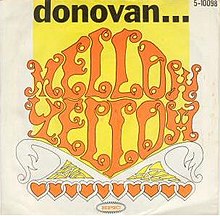
"Penny Lane" is a song by the English rock band the Beatles that was released in February 1967 as a double A-side single with "Strawberry Fields Forever". It was written primarily by Paul McCartney and credited to the Lennon–McCartney songwriting partnership. The lyrics refer to Penny Lane, a street in Liverpool, and make mention of the sights and characters that McCartney recalled from his upbringing in the city.
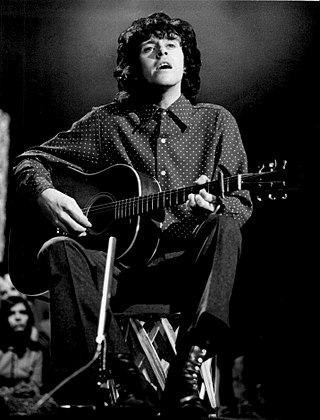
Donovan Phillips Leitch, known mononymously as Donovan, is a Scottish musician, songwriter and record producer. He developed an eclectic and distinctive style that blended folk, jazz, pop, psychedelic rock and world music. He has lived in Scotland, Hertfordshire (England), London, California, and—since at least 2008—in County Cork, Ireland, with his family. Emerging from the British folk scene, Donovan reached fame in the United Kingdom in early 1965 with live performances on the pop TV series Ready Steady Go!.

"96 Tears" is a song recorded by the American garage rock band? and the Mysterians in 1966. In October of that year, it was #1 on the Billboard Hot 100 in the U.S. and on the RPM 100 in Canada. Billboard ranked the record as the #2 song for 1966. It was ranked #213 on the Rolling Stone list of the 500 Greatest Songs of All Time in 2010. On November 11, 1966, the single was certified as gold by the RIAA.

"Sunshine Superman" is a song written and recorded by Scottish singer-songwriter Donovan. It was released as a single in the United States through Epic Records in July 1966, but due to a contractual dispute the United Kingdom release was delayed until December 1966, where it appeared on Donovan's previous label, Pye Records. The single was backed with "The Trip" on both the US and UK releases. It has been described as "[one of the] classics of the era", and as "the quintessential bright summer sing along".

"Hello, Goodbye" is a song by the English rock band the Beatles, written by Paul McCartney and credited to Lennon–McCartney. Backed by John Lennon's "I Am the Walrus", it was issued as a non-album single in November 1967, the group's first release since the death of their manager, Brian Epstein. The single was commercially successful around the world, topping charts in the United States, the United Kingdom, France, West Germany, Canada, Australia and several other countries.

"You Keep Me Hangin' On" is a song written and composed by Holland–Dozier–Holland. It was first recorded in 1966 by American Motown group the Supremes, reaching number one on the Billboard Hot 100. American rock band Vanilla Fudge released a cover version in June the following year, which reached number six on the Billboard Hot 100. English singer Kim Wilde covered "You Keep Me Hangin' On" in 1986, reaching number one on the Billboard Hot 100 in June 1987. In the first 32 years of the Billboard Hot 100 rock era, "You Keep Me Hangin' On" became one of the six songs to reach number one by two different musical acts. In 1996, American country singer Reba McEntire's version reached number two on the US Billboard Hot Dance Club Play chart. The BBC ranked the Supremes' original song at number 78 on The Top 100 Digital Motown Chart, which ranks Motown releases by their all-time UK downloads and streams.

"A Whiter Shade of Pale" is a song by the English rock band Procol Harum that was issued as their debut record on 12 May 1967. The single reached number 1 in the UK Singles Chart on 8 June and stayed there for six weeks. Without much promotion, it reached number 5 on the US Billboard Hot 100. One of the anthems of the 1967 Summer of Love, it is one of the most commercially successful singles in history, having sold more than 10 million copies worldwide. In the years since, "A Whiter Shade of Pale" has become an enduring classic, with more than 1,000 known cover versions by other artists.

"Reach Out I'll Be There" (also formatted as "Reach Out (I'll Be There)") is a song recorded by the Four Tops from their fourth studio album Reach Out (1967). Written and produced by Motown's main production team, Holland–Dozier–Holland, the song is one of the most widely-known Motown hits of the 1960s and is today considered the Four Tops' signature song.

"I'm a Believer" is a song written by Neil Diamond and recorded by American band the Monkees in 1966 with the lead vocals by Micky Dolenz. The single, produced by Jeff Barry, hit the number-one spot on the U.S. Billboard Hot 100 chart for the week ending December 31, 1966, and remained there for seven weeks, becoming the last number-one hit of 1966 and the biggest-selling single for all of 1967. Billboard ranked the record as the number-five song for 1967. While originally published by Screen Gems-Columbia Music (BMI), it is now published by Stonebridge Music/EMI Foray Music (SESAC), with administration passed to Sony Music Publishing and Universal Music Publishing Group.

Mellow Yellow is the fourth album from Scottish singer-songwriter Donovan. It was released in the US in February 1967 (Epic Records LN 24239 / BN 26239, but not released in the UK because of a continuing contractual dispute that also prevented Sunshine Superman from a UK release. In June 1967, a cross-section of both albums was released as Sunshine Superman in the UK. "Mellow Yellow" was the name of Donovan's hit single released the previous November.
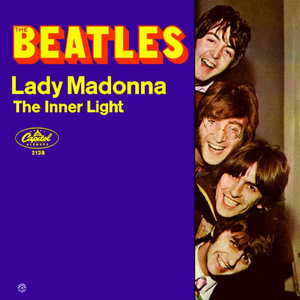
"Lady Madonna" is a song by the English rock band the Beatles, written primarily by Paul McCartney and credited to Lennon–McCartney. In March 1968, it was released as a mono single, backed with "The Inner Light". The song was recorded on 3 and 6 February 1968 before the Beatles left for India, and its boogie-woogie style signalled a more conventional approach to writing and recording for the group following the psychedelic experimentation of the previous two years.
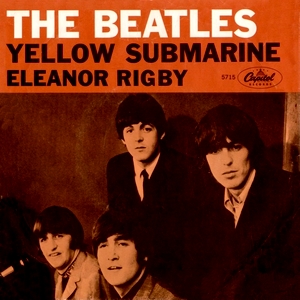
"Yellow Submarine" is a song by the English rock band the Beatles from their 1966 album Revolver. It was also issued on a double A-side single, paired with "Eleanor Rigby". Written as a children's song by Paul McCartney and John Lennon, it was drummer Ringo Starr's vocal spot on the album. The single went to number one on charts in the United Kingdom and several other European countries, and in Australia, Canada and New Zealand. It won an Ivor Novello Award for the highest certified sales of any single written by a British songwriter and issued in the UK in 1966. In the US, the song peaked at number two on the Billboard Hot 100 chart and number one on the Cash BoxTop 100 chart.

"I Can See for Miles" is a song by the English rock band the Who, recorded for the band's 1967 album The Who Sell Out. Written by guitarist Pete Townshend, it was the only song from the album to be released as a single.

"Silly Love Songs" is a song by the British–American rock band Wings that was written by Paul and Linda McCartney. The song first appeared in March 1976 on the album Wings at the Speed of Sound, then it was released as a single backed with "Cook of the House" on 1 April in the US, and 30 April in the UK. The song, which features disco overtones, was written in response to music critics accusing McCartney of predominantly writing "silly love songs" and "sentimental slush"; however, Paul has since clarified that the song was actually directed to John Lennon who accused him of writing such songs.

"Bang Bang (My Baby Shot Me Down)" is the second single by American singer-actress Cher from her second album, The Sonny Side of Chér. It was written by her husband Sonny Bono and released in 1966. The song reached No. 3 in the UK Singles Chart and No. 2 on the Billboard Hot 100 for a week (behind "(You're My) Soul and Inspiration" by The Righteous Brothers), eventually becoming one of Cher's biggest-selling singles of the 1960s.

"Live and Let Die" is the theme song of the 1973 James Bond film of the same name, performed by the British–American rock band Wings. Written by English musician Paul McCartney and his wife Linda McCartney, it reunited McCartney with former Beatles producer George Martin, who produced the song and arranged the orchestra. McCartney was contacted to write the song by the film's producers Harry Saltzman and Albert R. Broccoli before the screenplay was finished. Wings recorded "Live and Let Die" during the sessions for Red Rose Speedway in October 1972 at AIR Studios. It was also the first rock song to open a Bond film. Another version by B. J. Arnau also appears in the film.
"If I Were a Carpenter" is a folk song written by Tim Hardin in the 1960s, and re-recorded with commercial success by various artists including Bobby Darin, The Four Tops and Johnny Cash. Hardin's own recording of the piece appeared on his 1967 album Tim Hardin 2. It was one of two songs from that release performed by Hardin at Woodstock in 1969. The song, believed by some to be about male romantic insecurity, is rumored to have been inspired by his love for actress Susan Morss, as well as the construction of Hardin's recording studio.

"Take It Away" is a single by the English musician Paul McCartney from his third solo studio album Tug of War (1982). The single spent sixteen weeks on the Billboard Hot 100 singles chart, reaching #10 and spending five consecutive weeks at that position. It reached #15 in the UK. The music video, directed by John Makenzie, features former Beatles drummer Ringo Starr and long-time producer George Martin, both of whom played on the track, as well as actor John Hurt and Linda McCartney.
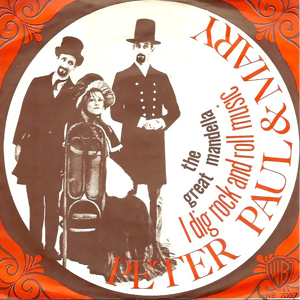
"I Dig Rock and Roll Music" is a 1967 song by the American folk group Peter, Paul and Mary, written by Paul Stookey, James Mason and Dave Dixon.

"How Sweet It Is (To Be Loved by You)" is a song recorded by American soul singer Marvin Gaye from his fifth studio album of the same name (1965). It was written in 1964 by the Motown songwriting team of Holland–Dozier–Holland, and produced by Brian Holland and Lamont Dozier. The song title was inspired by one of the actor and comedian Jackie Gleason's signature phrases, "How Sweet It Is!"
